
All images © by Roberto Piperno, owner of the domain. Write to romapip@quipo.it.
Notes:
Page revised in October 2020.

All images © by Roberto Piperno, owner of the domain. Write to romapip@quipo.it.
Notes:
Page revised in October 2020.
 Modern Churches in Historical Rome
Modern Churches in Historical Rome
Mark Twain visited Rome in 1867 and he wrote that there were some four hundred churches (The Innocents Abroad). Maybe the number was rounded up to impress his readers at home, but he was not the only one to
believe that Rome had far too many churches. In 1845 Charles Dickens noted in Pictures from Italy "I explored so many churches, that I abandoned that part of the enterprise at last, before it was half finished, lest I should never, of my own accord, go to church again, as long as I lived."
They both visited Rome in the last years of the Papal State which ended in 1870.
Rome became the capital of Italy on February 3, 1871 and the government, the court and the diplomatic corps relocated to Rome at the beginning of July.
One of the first acts of the Italian government was to confiscate a certain number of
monasteries to turn them into public offices and this led to the loss of some churches;
other churches were pulled down when the river banks were redesigned and high walls were built to prevent
floods; the enlargement of some streets caused the demolition of other churches (this occurred again in the 1930s).
Yet the number of churches within the walls of Rome has not decreased that much because a few churches were built after 1871.
These additions often fall into two categories:
a) they belong to Churches other than Roman Catholic;
the Papal Government did not allow the existence of "heretical" churches,
while the Italian Government had a lay approach to religious matters; it
encouraged the construction of these churches to show that Roman Catholicism was not the only professed religion in Rome;
b) they are located on the site of former villas (Lodovisi, Peretti and Altieri).
These areas saw the development of new quarters housing a large population: this led to the construction of some parish churches.
The two categories have commonalities: in general most of the churches are rather small;
they are not placed at one end of a square, but they directly face a street; they were designed in a variety of styles which did not fit the urban landscape of Rome.

Chiesa Evangelica Luterana (Christuskirche)
In 1817, for the third centenary of the Reformation, the first Lutheran ceremonies in Rome were held in the private lodgings of a Prussian Embassy secretary: a few years later a chapel was arranged in the Embassy premises at Palazzo Caffarelli. Because the German Lutheran community in Rome
was pretty small it was only in 1911 that work for the construction of a church started. The building was completed in 1922. It was designed in a mixture of German and Italian Romanesque by Franz Heinrich Schwechten, the architect of German Emperor William II. It is located, as many other modern churches, in the area of former Villa Lodovisi.
In 1983 Pope John Paul II visited the church on the fifth centenary of Martin Luther's birth.

Chiesa Anglicana Inglese (All Saints' Anglican Church); (left) the spire and Via del Babuino; (centre) stained glass portraying St. George; (right) entrance
The Anglicans living in Rome were allowed in 1825 to hold ceremonies in a former granary outside Porta del Popolo; the American Anglicans were the first to build a church within the walls: in 1872-1876 they built St. Paul's along newly opened Via Nazionale. The English Anglicans asked George Edmund Street, the architect of St. Paul's, to design their church on the site of a former monastery in Via del Babuino; the building was completed only in 1937 with the construction of the spire. The style is neo-Gothic with an interesting match of red bricks with travertine.

(left) Baptist church in Trastevere near S. Agata;
(right above) detail of the church; (right below) detail of the Baptist church in Piazza in Lucina
The Baptist community in Rome included both foreign and Italian followers, mainly due to the efforts of James Wall, an English preacher of the Baptist Missionary Society. He opened two meeting halls in Rome; both were decorated with a sentence from St. Paul's Epistle to the Romans (I, 16): "For I am not ashamed of the gospel of Christ: for it is the power of God unto salvation to everyone that believeth".
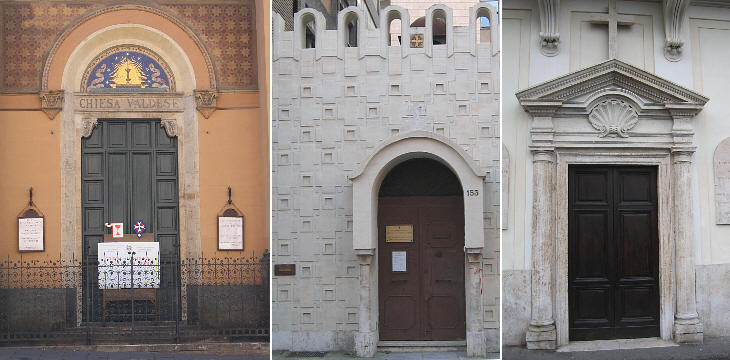
(left) Chiesa Valdese; (centre) S. Andrea; (right) Chiesa Metodista a Ponte
A street seller of Bibles was the first Waldense to set foot in Rome: he arrived on September 22, 1870, just two days after Italian
troops had entered the city. At that time Waldenses mainly lived in Piedmont where after centuries of harsh persecution they acquired legal freedom in 1848.
A certain number of Waldense
soldiers and civil servants followed the move of the capital from Florence to Rome; the community bought from the Colonna a piece of land near their palace: the church was completed in 1883; the design includes Romanesque and Renaissance features. Later on
the Waldenses built a larger church in Piazza Cavour.
A small Greek Orthodox chapel dedicated to St. Andrew was built in 1958 on the former site of the Greek Embassy, not far from the Lutheran Church. The historical Greek community living in Rome belonged to the Catholic Church and met for ceremonies at
S. Atanasio dei Greci.
Alessandro Gavazzi, who in 1860 served as chaplain with Giuseppe Garibaldi's army, was an Italian preacher who abandoned in 1855 Catholicism and became a leader of Italian Protestants. In 1877 he founded a small church opposite Ponte
S. Angelo along the traditional route pilgrims going to S. Pietro followed. The building now belongs to the Methodist Church.

(left) S. Andrea dei Presibiteriani Scozzesi - detail of the entrance; (right) Tempio Metodista di Via XX Settembre
The Presbyterian followers of the Church of Scotland who lived in Rome built in 1885 a church dedicated to St. Andrew along Via XX Settembre, which once was known as Strada Pia, not very far from S. Andrea degli Scozzesi,
the Catholic Scottish national church. The building does not show its religious purpose with the exception of its entrance which is decorated with the Burning Bush (the emblem of the Church of Scotland) and with the motto Nec tamen consumebatur ('Yet it was not consumed', an allusion to Exodus 3:2 and the Burning Bush).
Occasionally on Sundays ceremonies are cheered up by a true Scottish ensemble.
Methodist preachers came to Rome after 1870;
in 1895 Wiliam Burt, one of their leaders, promoted the construction of a large building with two meeting halls.
It is located almost opposite the Scottish church and it is designed in a patchy Renaissance style.
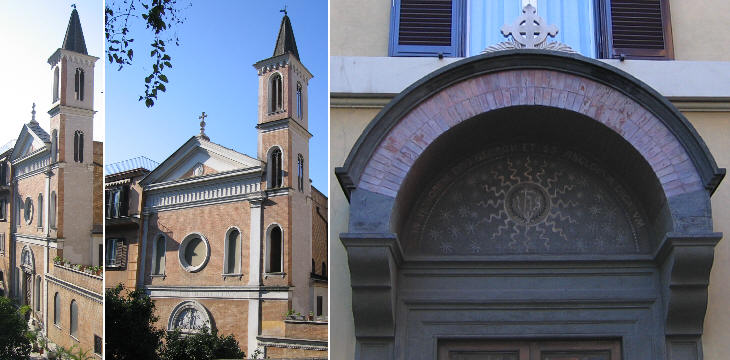
(left/centre) Chiesa della Risurrezione; (right) Chiesa di S. Giorgio e dei Martiri Inglesi (detail of the entrance)
Two small churches which were built along an almost hidden street behind Via Margutta
marked the beginning of a Catholic reaction; they were both built at the initiative of foreigners.
After the failed Polish 1830 insurrection three refugees founded in Paris the Congregation of the
Resurrection of Our Lord Jesus Christ. The Order was recognized in 1860 and it mainly acted in the Polish communities in the world. In 1888 Piotr Semenenko,
the Roman leader of the Order, built a church for the Polish patriots living in Rome who did not like meeting at S. Stanislao dei Polacchi, the historical church of their Nation.
This because in that church they could be overheard by tsarist spies.
Almost at the same time English Anglicans built All Saints, Mother Magdalen Taylor, an English Catholic, built a small chapel dedicated to St. George and to the English Martyrs.
She was born Frances Taylor; in 1854 she joined in Crimea a group of nurses led by Florence Nightingale; there she was impressed by the faith of young Irishmen who had joined the army.
In 1855 she converted to Catholicism and in 1869 she
founded a religious order, the Poor Servants of the Mother of God. She then changed her name into Mother Magdalen Taylor.

(left/centre) Sacro Cuore a Castro Pretorio: 1931 bronze statue and a mosaic portraying St. Francis de Sales; (right) S. Vincenzo de Paoli
Pope Leo XIII followed the policy of his predecessor Pope Pius IX and claimed
the illegitimacy of the Italian occupation of Rome; he nevertheless acted to emphasize the role of the Church
as a shepherd caring for his flock, rather than as an institution involved in worldly affairs:
he helped the development of the Salesian Order of St. John Bosco which promoted the
education of poor children. John Bosco was charged with looking after the construction of a hospice and of a
church for the inhabitants of the new quarter around Stazione Termini.
The design of the church (which was completed in 1887) is reminiscent (in the use of mosaics and of a very white stone) of the way S. Paolo fuori le Mura was reconstructed.
A huge statue was placed on the top of the bell tower in 1931 after the
reconciliation between the Italian State and the Catholic Church.
The Daughters of Charity of St. Vincent de Paul was another order caring for the sick and the poor and it
built in 1893 a monastery with a simple church near S. Maria in Cosmedin.

(left/centre) S. Antonio da Padova; (right) S. Anna
In November 1885 the Franciscan members of the Order of Friar Minors had to leave their historical
monastery near S. Maria d'Aracoeli which was going to be pulled down to make room for a
Monumento a Vittorio Emanuele II. The Order bought from the owners of Villa Giustiniani a parcel of land where they built their headquarters (which later on were greatly enlarged) and a church which was completed in 1887;
its design is mainly neo-Renaissance with a not so Roman bell tower.
Via Merulana was a street opened by Pope Sixtus V; it was enlarged after 1871 and many apartment blocks were built along it. In 1886 a new church provided spiritual assistance to residents; the church was entirely rebuilt in 1927 in a neo-Renaissance style.
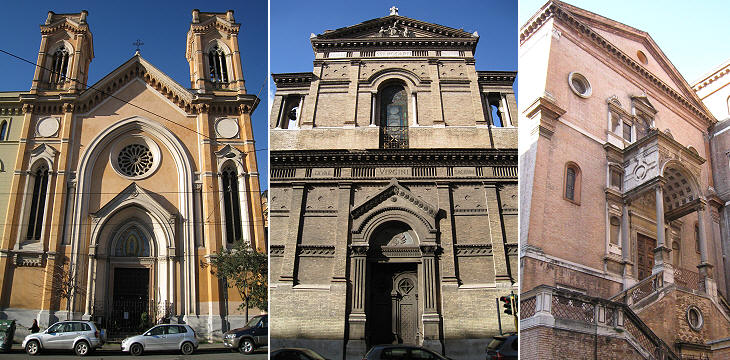
(left) S. Maria Immacolata all'Esquilino; (centre) S. Maria del Rosario di Pompei; (right) S. Giuseppe di Cluny
The second half of the XIXth century was a period of crisis for the Roman Catholic Church from a political point of view, but not from a religious one; new orders were founded and among them that of the Gray Friars who devoted themselves to the education of African children. The order built a church in Rome on the Esquilino hill; its construction took a very long time (18 years); the order was dissolved in 1973 and now the church is a subsidiary location for the nearby parish of SS. Pietro e Marcellino.
Pompeii is known worldwide for its archaeological area; in southern Italy the faithful know it for a large sanctuary built between 1876 and 1901; it was dedicated to S. Maria del Rosario and it attracts crowds comparable to those who visit the ancient town. A church was dedicated to S. Maria del Rosario di Pompei in Rome too; it was designed in a mixture of styles and it directly faces a very busy street; smog has given it a rather gloomy appearance.
The church dedicated to S. Giuseppe di Cluny was built in the same period as the preceding two; it is part of a nunnery. The Society of St. Joseph of Cluny was founded in 1807 in France; its objective was to promote missionary activities.

(left) Sacro Cuore al Sallustiano; (centre/right) S. Alfonso dei Liguori: fašade and relief showing a copy of "Madonna del Perpetuo Soccorso", a miraculous image
A (vaguely) Gothic design was not a feature limited to non-Catholic churches. In 1916 a church of this style was built on a piece of land which belonged to Villa Paolina: the area had become a residential and commercial one and it had no historical churches.
An earlier example of Gothic is provided by S. Alfonso dei Liguori, one of the last churches built during the papal rule. It was designed in 1855 by George Wigley, an English architect who was one of the founders of the Society of Saint Vincent de Paul. The church was dedicated to the saint who founded the Redemptorists' Order. It houses a sacred image which once was in nearby S. Eusebio.

(left 1-2) S. Patrizio; (right 3-4) S. Lorenzo da Brindisi
Overall the prevailing style of the churches built after 1871 is Romanesque and in particular that which flourished in Lombardy: it was characterized by decorative blind arcades.
S. Patrizio was built in 1911 on a piece of land of former Villa Lodovisi by Irish Augustinian monks who had to leave S. Maria in Posterula, a small church which was pulled down to make room for the new quays along the Tiber.
Mark Twain was impressed by the number of churches named after Mary and a limited number of saints, among which he quoted St. Lawrence (the Martyr). Those who built new churches after 1871 seem to have taken into account this complaint; they dedicated many churches to saints who were not honoured in Rome. The Capuchins celebrated the 1881 canonization of St. Lawrence of Brindisi (1559-1619), a member of their order, by dedicating a church to him; it is located very near S. Patrizio, it was built at the same time and in the same style.

Chiesa dei Maroniti (S. Marone)
Maronites are members of a mainly Lebanese Church which recognizes the supremacy of the Pope. Until the 1830s they had a small church (S. Giovanni dei Maroniti) near Collegio Nazzareno. Elias Hoysk, a Maronite Patriarch, promoted the construction of a new Maronite church in Rome. The building was completed by 1914: the design of the fašade vaguely resembles a triumphal arch. This church is located on the site of former Villa Lodovisi.
This church which was completed in 1910 near Horti Sallustiani is regarded as the finest example of the Romanesque revival in Rome. It would have gained from being placed in a small square, rather than on a very busy road. It serves as parish church for a large area between Via XX Settembre and the walls of Rome. Camillo de Lellis (1550-1614), a friend of St. Philip Neri, is the patron saint of nurses.
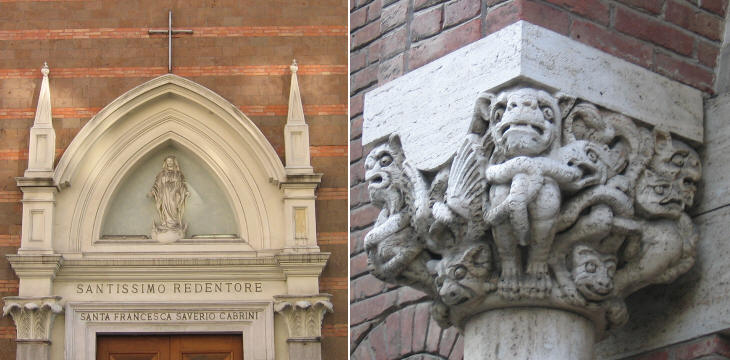
(left) SS. Redentore; (right) S. Maria Regina dei Cuori
St. Frances Xavier Cabrini was the first American citizen to be canonized. Mother Cabrini (as she was usually called) promoted the construction of a small church for the nuns of the order she founded in 1880 (Missionary Sisters of the Sacred Heart of Jesus).
The church was completed in 1906; its design is very simple, the only exception being that of the portal.
An even smaller church was built in the same area (former Villa Lodovisi) by the members of the Company of Mary, a missionary organization founded by St. Louis de Montfort in 1713. The founder was beatified in 1888.
Because of their particular devotion to Mary, they dedicated the church to her and she was called the Queen of Hearts. The church was completed in 1913 and it was decorated with typical medieval Romanesque capitals.
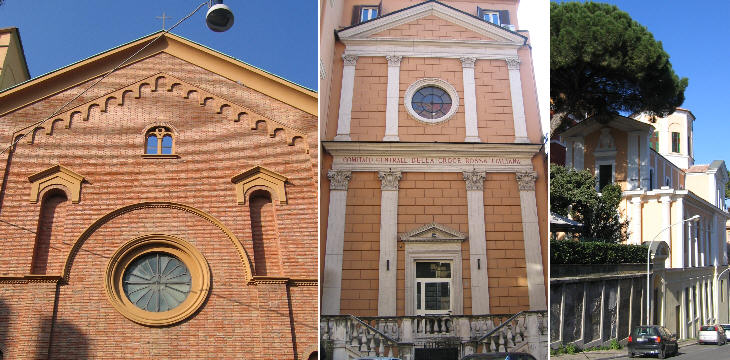
(left) Corpus Christi; (centre) S. Giuseppe Calasanzio; (right) S. Antonio Maria Zaccaria
Two other small churches were built in the area of former Villa Lodovisi: a)
Corpus Christi was completed in 1907: it was designed in a very simple Romanesque style and it
adjoined a nunnery of the Capuchin Poor Clares; b) S. Giuseppe Calasanzio was completed in 1892 and it served as chapel for the nearby headquarters of the Order of the Piarists, founded by St. Joseph Calasanctius (1557-1648). In 1918 the building, including the chapel, was sold to the Italian Red Cross and that explains the inscription "Comitato Centrale della Croce Rossa Italiana.
At the opposite side of Rome, near Villa Sciarra, in 1933
the Barnabites dedicated a church to one of the founders of their order; the church is part of an international seminary.
The image used as background for this page shows a mosaic in the portal of S. Lorenzo da Brindisi.

